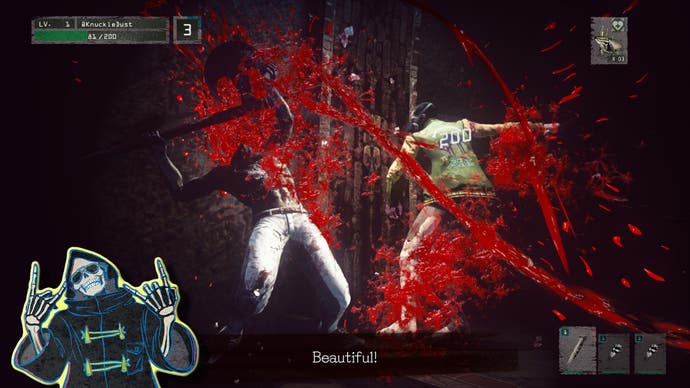Why Let it Die's microtransactions are great for the game
Never mind the goofy grim reaper, Grasshopper makes death proper scary.
Last month I wrote some pretty positive impressions of Grasshopper Manufacture's procedurally-generated "survival action" game Let it Die, though I was unsure how the game would hold up in the long run, what with its free-to-play micro-transactions based design that threatened to suffocate the adventure's more challenging later stages. In fact, shortly after penning that piece, I hit something of a wall that nearly torpedoed my interest in continuing to play it. But boy am I glad I worked past that.
But first, some background on how Let it Die's death system works. When your character meets their end, there are three ways to revive the one's fallen avatar. One: you use a different character to defeat your now villainous previous avatar, Zombi-U style. Two: you spend some in-game currency, Kill Coins, to revive your previous character (which allows them to keep all the items and XP they had on them when they fell). Or three: you spend the game's very rare Death Metals to revive someone right where they fell, ala a fairy in Zelda. The tricky thing about Death Metals is they're mostly only obtainable by buying them from the PlayStation Network for roughly $0.50 a pop (sold in minimum bundles of 10) or received periodically as daily login gifts.
As for me, roughly seven hours into Let it Die my options to continue were slim. I'd run out of the few free Death Metals I'd received upon beginning the game, my Kill Coin coffers were skint, and starting a new level one character would be a waste as they wouldn't stand a chance at defeating my perished level 25 warrior. Even purchasing Death Metals seemed like a fool's errand after throwing everything I had at a boss only to end up broke, armourless, and with few items and weapons to defeat my seemingly overpowered opponent. As such, my choices were simple: grind for a bit with a fresh character or quit.
I quit.

But a funny thing happened that pulled me back in. During the holidays, a friend and big fan of Let it Die came over and decided to examine my plight. Seeing my poor position he nonchalantly re-rolled a brand new character - a choice that initially seemed dispiriting to me after seven hours of investment with my main avatar. But watching him start from scratch with this new character made me realise something magical about Let it Die: its alleged grinding isn't grinding at all!
Due to the game's procedurally-generated layouts, enemy placements and item scavenging, this secondary adventure remained almost as thrilling as my initial voyage. (I say "almost" only because the bosses and basic aesthetics remain the same.) With no telling where foes would pop out, what they'd be armed with, or how the labyrinth was designed, the moment-to-moment feeling of ascending Let it Die's sole setting, The Tower of Barbs, continued to surprise.
That's true of any roguelike though. What makes Let it Die so devilishly clever is that even though repeating stages is enjoyable, deep down you're never actually excited at the prospect of doing it, not when new progress is just around the corner, anyway. Reclaiming your former position is a consolation prize, while success in battle is always the primary goal.
That's what makes death in Let it Die so meaningful. Upon meeting your maker, you must make a decision: do you want to do the enjoyable, albeit time-consuming, activity of reclaiming what you've lost? Or do you want to spend a rare resource, obtained through spending real money, to hopefully access an allegedly more enjoyable, more surprising activity in the stages ahead? Of course, you may end up spending Death Metals only to still fail at a boss, and then won't you feel silly? Decisions, decisions...

Let it Die's DNA is obviously found in Dark Souls with its third-person combat, in Monster Hunter with its emphasis on loot acquisition and crafting, and in Resident Evil with its intentionally limited inventory, but in many ways Let it Die has just as much in common with poker as it does any of its video game brethren.
I'm not an especially skilled poker player, but I relish playing with friends for very low stakes of nickels, dimes and quarters. With the stakes so low, putting a couple bucks into the pot suddenly feels epic in scale. More often that not, Let it Die offers convenient options to resurrect one's primary character, but the threat of having to grind or cough up a few quid is always there, looming in the background.
Unless you really get carried away, Let it Die is not costly, at least not monetarily. But failing in Let it Die is costly compared to most other games, where the penalty for dying is to be set back a few minutes or go on another bite-sized roguelike adventure that costs zero legal tender once the player has already purchased the product.
In one of Let it Die's most clever twists, the game is framed as a video game set within a video game where the usual Grasshopper oddballs pump quarters into arcade machines. Let it Die seeks to replicate that financial stress of deciding whether to slide another quarter into the coin slot. Where most games like Mass Effect or The Walking Dead build their tension by asking players to invest in their fiction, Let it Die's partially micro-transaction based continue system ups the stakes by asking you to weigh the consequences outside of it. Let it Die may not be a horror game in the conventional sense, but its harsh penalty for failure makes it the most terrifying game I played in 2016.









